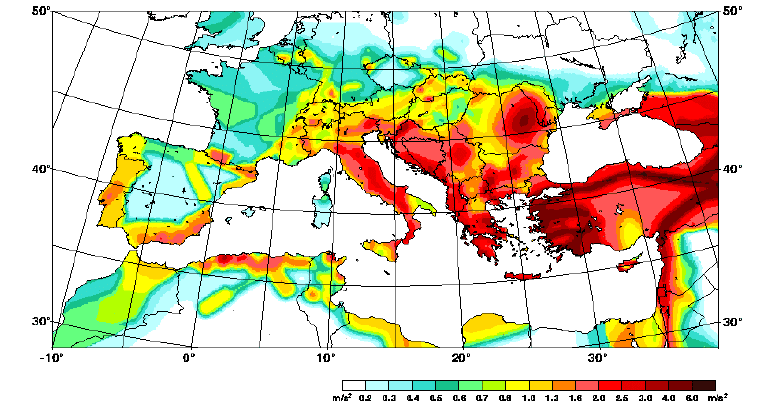Peak Ground Acceleration | Facts the Aware
The maximum acceleration of the ground that occurs in an event of an earthquake is known as peak ground acceleration (PGA). The PGA is discussed about a particular location. It is the maximum acceleration at the site we considered for the design.
Ground movement due to an earthquake occurs in any direction. During the design, for simplification, we considered vertical acceleration and horizontal acceleration.
Generally, horizontal acceleration is critical. However, it does not always happen. Especially, when the site is close to the location where the earthquake occurs, the vertical acceleration would be critical.
How to Consider Peak Ground Acceleration of Design
The dominant parameter of the earthquake design is the peak ground acceleration. Correct estimation of the probable PGA value based on the return period considered for the design is very important. Overwise we will be ended up with the wrong answer which is an overdesign or making a vulnerable structure for earthquake failure.
These two concerns are to be addressed during the design for earthquake load calculation.
- The available seismic data at the particular area. Since we are designing for a probable earthquake, it is very important to have an accurate date to estimate the structural behavior. Inadequate data or unavailability of the data causes issues and challenges for the designers.
In these instances, we estimated the based on the experience and available information close to the referred location. Further, distance to the plate boundaries is also could be considered for this assessment in addition to the other relevant parameters.
- The second important parameter to be considered is the return period. It is considered when determining how large a force is to be considered for the design of the structure.
Fundamental Behind PGA
- PGA is considered in the vertical and horizontal design for the design. Mostly the horizontal peak ground acceleration is critical.
- PGA depends on the distance to the structure and to the location where the earthquake occurs. The origin of the earthquake is known as the epicenter.
- In addition, PGA depends on the geology of the ground, how deep the earthquake occurs, etc.
- PGA represents the multiples of the gravitational acceleration (g = 9.81 m/s2). For example, Peak ground acceleration can be written as 0.1g.
Significance of the PGA
We do feel the acceleration. Not only the earthquake, but wind also induces acceleration felt when it exceeds a certain level. According to the general considerations, the following can be considered as the critical ranges of human comfort.
However, these values may not apply to the building differently. We have to consider the acceleration depending on the factors discussed above when designing.
| Acceleration | Multiple of damage damage | Damage/Comfort Level |
| 0.01 m/s2 | 0.001g | People feels movement |
| 0.2 m/s2 | 0.02g | People lose their balance |
| 5 m/s2 | 0.50g | Very High Acceleration. Well designed buildings with a short period of adequate damping would survive. |
The following table is an extraction from Wikipedia on the variation of the acceleration and other relevant parameters published by the United State Geological Survey.
| Instrumental Intensity | Acceleration (g) | Velocity (cm/s) | Perceived shaking | Potential damage |
| I | < 0.000464 | < 0.0215 | Not felt | None |
| II–III | 0.000464 – 0.00297 | 0.135 – 1.41 | Weak | None |
| IV | 0.00297 – 0.0276 | 1.41 – 4.65 | Light | None |
| V | 0.0276 – 0.115 | 4.65 – 9.64 | Moderate | Very light |
| VI | 0.115 – 0.215 | 9.64 – 20 | Strong | Light |
| VII | 0.215 – 0.401 | 20 – 41.4 | Very strong | Moderate |
| VIII | 0.401 – 0.747 | 41.4 – 85.8 | Severe | Moderate to heavy |
| IX | 0.747 – 1.39 | 85.8 – 178 | Violent | Heavy |
| X+ | > 1.39 | > 178 | Extreme | Very heavy |
Relationship between PGA and Earthquake Magnitude
It appears that there is no direct relationship between the peak ground acceleration and the magnitude of an earthquake. PGA is at the site, and it varies from location to location for the same earthquake. However, there seem to be empirical relationships.
PGA depends on many factors such as distance to the structure from the epicenter, geological condition of the ground, wave Parth, method of occurrence of the earthquake, size of the earthquake, etc.
The following seismic data reordered in the earthquake also indicate the difficulty in forming a direct relationship between the peak ground acceleration and the Magnitude of the earthquake which is measured on the Richter Scale.
| PGA Maximum; single direction | Magnitude | Depth | Year and Location |
| 1.46 g | 6.4 | 17.9 km | 2022 Ferndale earthquake |
| 1.26 g | 7.1 | 10 km | 2010 Canterbury earthquake |
| 1.25 g | 6.6 | 8.4 km | 1971 Sylmar earthquake |
| 1.04 g | 6.6 | 10 km | 2007 Chūetsu offshore earthquake |
| 1.0 g | 6.0 | 8 km | December 2011 Christchurch earthquake |
| 0.65 g | 8.8 | 23 km | 2010 Chile earthquake |
| 0.18 g | 9.2 | 25 km | 1964 Alaska earthquake |
Source: Wikipedia




